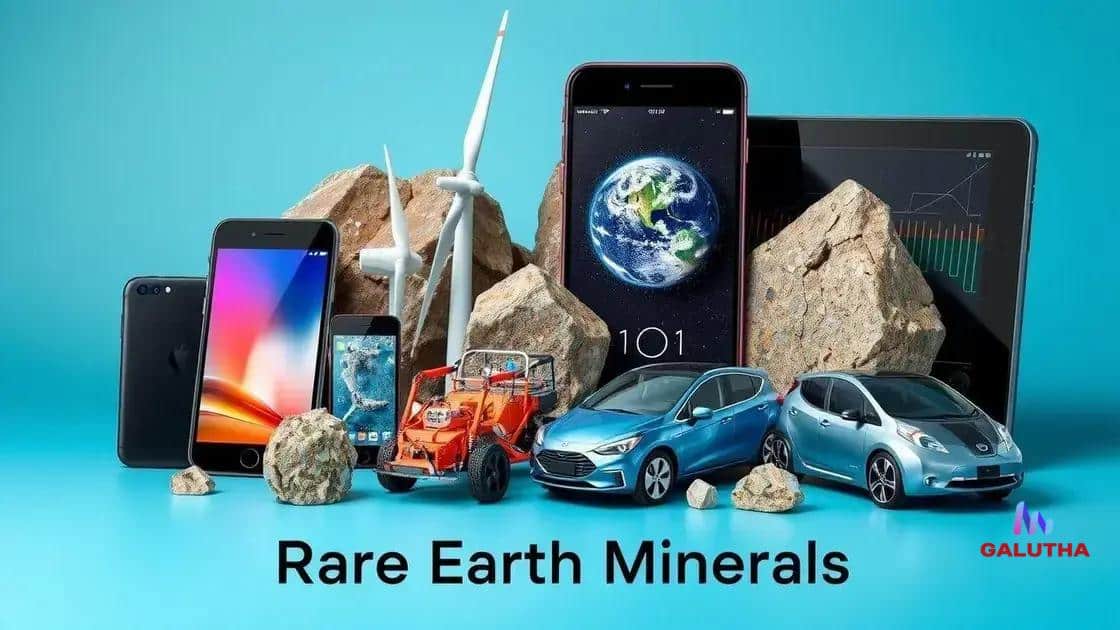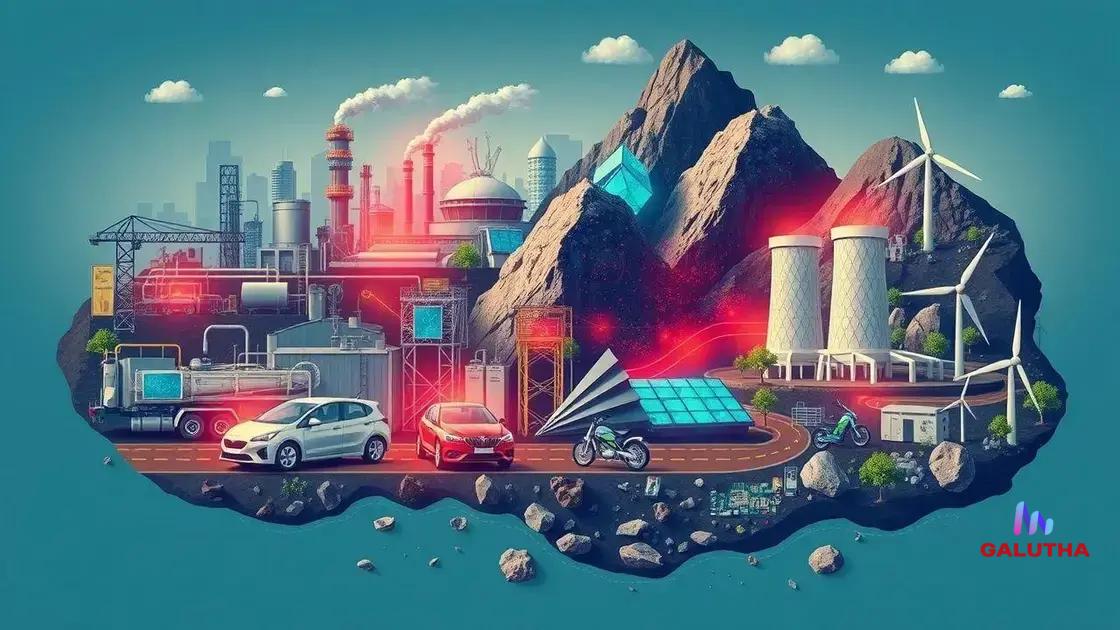Rare earth mineral export restrictions and their impact
Rare earth mineral export restrictions directly impact industries by increasing costs and supply shortages, crucial for technologies like electronics and renewable energy systems.
Rare earth mineral export restrictions have become a hot topic in recent years. If you’ve ever wondered how these restrictions influence our technology and economy, you’re not alone. Let’s dive into their significance.
Understanding rare earth minerals
Understanding rare earth minerals is essential in today’s tech-driven world. These minerals play a crucial role in various industries, especially electronics and renewable energy.
What Are Rare Earth Minerals?
Rare earth minerals consist of 17 elements in the periodic table, including lanthanum, cerium, and neodymium. They are not actually rare, but they are challenging to extract and refine, making them valuable.
Why Are They Important?
These minerals are vital for producing high-tech devices like smartphones, batteries, and electric cars. Without them, our reliance on technology would be significantly hindered.
- They enhance the performance of electronics.
- They are essential for green technologies.
- They are used in defense applications.
Furthermore, the production of rare earth minerals comes with environmental challenges. Mining and refining often lead to pollution and habitat destruction. Striking a balance between demand and environmental stewardship is crucial.
As global demand increases, countries are racing to secure supplies of these minerals. Understanding their significance can help us appreciate their role in our daily lives and future technologies.
The importance of rare earth minerals in technology

The importance of rare earth minerals in technology cannot be overstated. These minerals enable innovations and advancements in various fields, from electronics to clean energy.
Key Roles in Electronics
Rare earth minerals are found in many electronic devices like smartphones, tablets, and computers. They help improve the performance and efficiency of these gadgets.
- Used in high-strength magnets.
- Essential for LED lights.
- Critical for rechargeable batteries.
In addition to consumer electronics, rare earth minerals play a significant role in the defense industry. They are crucial for military technologies, such as precision-guided weapons and radar systems, ensuring national security.
Advancements in Renewable Energy
As the world shifts towards renewable energy, rare earth minerals are vital in the manufacturing of wind turbines and electric vehicles. These technologies reduce carbon emissions and depend less on fossil fuels.
Many green technologies rely on rare earth elements for their functionality. However, as demand grows, it becomes essential to manage these mineral resources sustainably. This can help protect the environment while meeting the rising need for technological advancements.
Current global export restrictions
Current global export restrictions on rare earth minerals are shaping the market landscape. These restrictions are often put in place to protect national resources and promote domestic industries.
Countries Imposing Export Controls
Several countries have enacted measures to control the export of rare earth minerals. These regulations can impact global supply chains and prices, leading to increased tension among trading partners.
- China is the largest producer and often restricts exports to maintain its market dominance.
- India is developing its own resources and may implement restrictions for similar reasons.
- The US is exploring policies to diversify sources and reduce dependence on foreign minerals.
The impact of these export restrictions is felt worldwide. Companies that rely on rare earth minerals for production often find themselves scrambling to secure supplies. As nations prioritize their own needs, the international market can become volatile.
Consequences of Export Restrictions
These restrictions can lead to a number of consequences. For one, prices for rare earth minerals may increase. This affects industries ranging from electronics to renewable energy.
Additionally, countries that find themselves unable to access these vital minerals may face challenges in maintaining their technological advancements. As export restrictions continue, the global landscape of rare earth minerals will likely evolve, pushing countries to rethink their strategies for resource management.
Impact on industries relying on rare earth minerals

The impact on industries relying on rare earth minerals is significant. These minerals are essential for various sectors, including electronics, automotive, and renewable energy, influencing both innovation and production processes.
Electronics Industry
The electronics industry is one of the primary users of rare earth minerals. These elements are vital for creating components like batteries, screens, and magnets. A shortage in supply can slow down production and lead to increased costs for consumers.
- Smartphones and laptops utilize these minerals for functionality.
- High-performance magnets are crucial for speakers and motors.
- Components might become more expensive, affecting overall pricing.
Additionally, companies must adapt to rising costs and potential shortages. They are often forced to find alternative materials or invest in research for substitutes. This may impact innovation timelines and product availability.
Automotive Sector
In the automotive sector, rare earth minerals are significant for producing electric vehicles (EVs) and hybrid cars. They help in the development of batteries and electric motors, making them more efficient.
As demand for EVs grows, so does the need for these minerals. A fluctuation in their availability can directly affect the production rates of vehicles. Manufacturers may face delays and increased prices if the supply chain is disrupted.
Over time, these challenges can push industries to explore sustainable alternatives to rare earth minerals, leading to innovation in materials science and manufacturing processes.
| Sector | Impact | Example |
|---|---|---|
| Electronics | Increased production costs | Smartphone manufacturers facing higher prices |
| Automotive | Supply chain disruptions | Electric vehicle production delays |
| Renewable Energy | Project postponements | Wind turbine installations delayed |
| Defense | National security concerns | Limited access to critical components |
Future trends in rare earth mineral exports
Future trends in rare earth mineral exports indicate a dynamic landscape shaped by global demand and environmental considerations. As countries strive for technological advancements, the need for these minerals will continue to grow.
Increasing Demand from Emerging Technologies
With the rise of electric vehicles and renewable energy solutions, the demand for rare earth minerals is expected to surge. These technologies rely heavily on rare earth elements for batteries and motors.
- Electric vehicles depend on materials like neodymium for efficient motors.
- Wind turbines require specific rare earth elements to function effectively.
- Smart technologies and electronics need these minerals for advanced features.
As industries evolve, businesses will likely seek more sustainable ways to source and utilize these materials. Companies are already investing in research to improve recycling processes and find alternatives to rare earths.
Geopolitical Influences
The geopolitical landscape will also impact future trends in rare earth mineral exports. Trade relationships between countries, along with export regulations, will shape supply chains.
Countries like China currently dominate the rare earth market. However, nations are motivated to develop their own resources to reduce reliance on imports. This shift can lead to new players entering the market, which may alter global trade dynamics.
Developing new mines and enhancing domestic capabilities will be essential for countries looking to secure their supply chains. This exploration will likely impact both pricing and availability on the global stage.
In conclusion, the landscape of rare earth minerals is rapidly changing due to increasing demand and geopolitical factors. As industries rely heavily on these minerals, understanding their importance is vital for future innovations. Countries are adapting their strategies to secure supplies and reduce dependency on imports. The focus on sustainability and alternative materials will likely shape the market moving forward. This dynamic environment presents both challenges and opportunities for businesses and consumers alike.
FAQ – Frequently Asked Questions About Rare Earth Minerals
What are rare earth minerals used for?
Rare earth minerals are used in various industries, including electronics, automotive, and renewable energy, to produce high-performance components.
Why are rare earth minerals important for technology?
They are essential for manufacturing devices like smartphones, electric vehicles, and wind turbines, driving innovation and energy efficiency.
How do export restrictions affect the market?
Export restrictions can lead to supply shortages and increased prices, impacting industries that rely heavily on these materials.
What are future trends in the rare earth mineral market?
Future trends include increasing demand from emerging technologies, a focus on sustainability, and changing geopolitical dynamics in trade.





